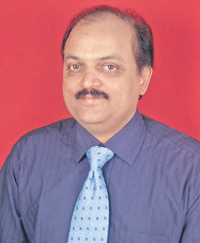Headquartered in Germany, Kontron is a leading embedded computing technology provider. With more than 30 per cent of its employees in R&D, Kontron creates many of the standards that drive embedded computing platforms.
In India, the company has expansion plans for design services and system integration in selected market verticals for local customers. Pradip Kulkarni, managing director, Kontron Technology India, speaks to Uma Gupta of EFY on the trends in small-form-factor embedded computing and Kontron’s activities in India.

JANUARY 2012 Q. How are highly integrated small-form factors (SFFs) redefining different application areas?
A. We can spot the SFF trend everywhere. It is generic for all application areas being a purely technology-driven improvement, which is applied by all silicon vendors. This is because all applications benefit from reduced power consumption and lower heat dissipation. Also, every application benefits from a reduced bill of material due to more efficient and simplified system designs. Of course, some application areas benefit in particular, e.g., mobile devices, because it enables increasing computing and graphics power on even smaller footprints.
Q. What are the chipsets and processors at the heart of these platforms?
A. In line with the different application areas addressed, there is also differentiation between several processors and chipsets. In the x86 space it is definitely the Intel Atom processor technology that has opened a new market for SFF designs. Not to forget the field-programmable growth array (FPGA) implementation of the Intel Atom 6×5 processors, which is most interesting for highly integrated platforms.
But AMD has also made a significant contribution to the SFF area with its so-called accelerated AMD embedded G-Series processors, which unite the CPU together with a GPU on a single die. The latest ARM processor platforms from NVIDIA as well as from Texas Instruments are catching up on the x86 technology with respect to the performance of ultra-low-power applications, and are also good examples of the SFF trend towards smart embedded devices with attractive graphical user interfaces.
Q. How easy is to integrate these for desired applications?
A. x86 technologies are widely used and embrace a huge ecosystem in terms of standard platforms, inputs/outputs and software support. Things are different for the ARM sector because here usually one receives only dedicated support for dedicated devices. If something more sophisticated or tailored to the customer‘s needs is required, one basically has to take care of this himself because there are no standardised procedures.
This has changed with Kontron launching the new SFF computer-on-modules standard—a low-power embedded architecture platform for ARM and system-on-chip (SoC) designs along with extensive software services. The new component object model (COM) standard features two SFFs designed for the future ultra-low-power, off-the-shelf platforms, including embedded handheld devices and rugged tablets, as well as box PCs and human-machine interface systems.
By extending the COM usage model to reduced instruction set computing (RISC) architectures with scalable, modular and out-of-the-box solutions, this module standard bridges the gap between current proprietary industrial offerings and offerings from the consumer market—a far less suitable solution for demanding environments.
Q. What top technologies do you see critical to the future of SFF and why?
A. Nothing can stop the trend towards SFF designs. The only question is, which technology will lead in the long term? Making the right decision on this matter today is critical for many OEMs. Since we do not want to rely on the success of only one specific chip maker, we support all relevant technologies used in this area starting with x86 technologies and extending it towards ARM technologies.
Q. What are the issues to be tackled?
A. As the embedded computer market establishes with reliable embedded form factors from different vendors, the market for RISC-based SFF devices needs to be standardised as well because embedded OEMs need long-term stable platforms to facilitate these technologies.
Q. How active is Kontron in the SFF space?
A. In terms of x86 technologies, Kontron has been the leading company in the SFF sector. An example of this is that Kontron specified the world‘s leading de-facto standard ETX and has also been the main force behind the COM Express standard. Complementary to this, Kontron has now specified a new standard for SFF ARM modules. Kontron also specified and launched the world’s first vendor-independent credit card-sized module specification named DIMM-PC for ISA-based system designs.










